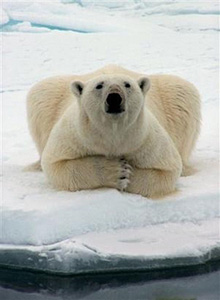 |
 |
 |
 Editorials | Environmental | May 2007 Editorials | Environmental | May 2007  
Smithsonian Toned Down Exhibit on Arctic
 Brett Zongker - Associated Press Brett Zongker - Associated Press


| | In recent months, the White House has been accused of trying to muzzle scientists researching global warming at NASA and other agencies. |
The Smithsonian Institution toned down an exhibit on climate change in the Arctic for fear of angering Congress and the Bush administration, says a former administrator at the museum.

Among other things, the script, or official text, of last year's exhibit was rewritten to minimize and inject more uncertainty into the relationship between global warming and humans, said Robert Sullivan, who was associate director in charge of exhibitions at the Smithsonian's National Museum of Natural History.

Also, officials omitted scientists' interpretation of some research and let visitors draw their own conclusions from the data, he said. In addition, graphs were altered "to show that global warming could go either way," Sullivan said.

"It just became tooth-pulling to get solid science out without toning it down," said Sullivan, who resigned last fall after 16 years at the museum. He said he left after higher-ups tried to reassign him.

Smithsonian officials denied that political concerns influenced the exhibit, saying the changes were made for reasons of objectivity. And some scientists who consulted on the project said nothing major was omitted.

Sullivan said that to his knowledge, no one in the Bush administration pressured the Smithsonian, whose $1.1 billion budget is mostly taxpayer-funded.

Rather, he said, Smithsonian leaders acted on their own. "The obsession with getting the next allocation and appropriation was so intense that anything that might upset the Congress or the White House was being looked at very carefully," he said.

White House spokeswoman Kristen Hellmer said Monday: "The White House had no role in this exhibit."

In recent months, the White House has been accused of trying to muzzle scientists researching global warming at NASA and other agencies.

The exhibit, "Arctic: A Friend Acting Strangely," based partly on a report by federal scientists, opened in April 2006 - six months late, because of the Smithsonian's review - and closed in November, but its content remains available online. Among other things, it highlighted the Arctic's shrinking ice and snow and concerns about the effect on people and wildlife.

This is not the first time the Smithsonian has been accused of taking politics into consideration.

The congressionally chartered institution scaled down a 1995 exhibit of the restored Enola Gay, the B-29 that dropped the atomic bomb on Hiroshima, after veterans complained it focused too much on the damage and deaths. Amid the oil-drilling debate in 2003, a photo exhibit of Alaska's Arctic National Wildlife Refuge was moved to a less prominent space.

Sullivan said the changes in the climate-change exhibit were requested by executives who included then-museum Director Cristian Samper and his boss, former Undersecretary for Science David Evans. He said several scientists whose work was used in the exhibit objected to the changes.

Samper, now acting Smithsonian secretary, said he was not aware of scientists' objections, and he emphasized there was no political pressure to change the script. "Our role as a museum is to present the facts but not advocate a particular point of view," Samper said in an e-mail.

Evans refused to comment.

Randall Kremer, a spokesman for the natural history museum, said atmospheric science was outside the Smithsonian's expertise, so the museum avoided the issue of what is causing the Arctic changes.

Many leading scientists have come to believe that human activity is contributing to warming of the planet.

"I see it in some ways as similar to the sort-of debate that has taken place with regard to the science of evolution," said Professor Michael Mann, director of Pennsylvania State University's Earth System Science Center. "Just as I would hope that the Smithsonian would stand firmly behind the science of evolution, it would also be my hope that they would stand firmly behind the science that supports influence on climate. Politically, they may be controversial, but scientifically they are not."

Some curators and scientists involved in the project said they believed nothing important was omitted. But they also said it was apparent that science was not the only concern.

"I remember them telling me there was an attempt to make sure there was nothing in there that would be upsetting to any politicians," said John Calder, a lead climate scientist at the National Oceanic and Atmospheric Administration who consulted on the project. "They're not stupid. They don't want to upset the people who pay them."

One consultant, University of Maryland scientist Louis Codispoti, said he would have been less cautious. "I've been going to the Arctic since 1963, and I find some of the changes alarming," he said.

On the Net: Smithsonian Forces of Change Arctic Exhibit | 
 | |
 |



